Robert Wickens is one of those drivers whose competitive nature is encoded in his DNA. A racer’s racer, he climbed the global motorsports ladder, competing in nearly every European open-wheel championship, eventually rounding it out with several years racing Mercedes-AMGs in German touring cars (DTM). Prior to his stint in IndyCar, Wickens was unknown to most Americans. On the other side of the border, however, he was a legend among Canadian racing fanatics. To them, Wickens had already made it.
In 2018, he returned to open wheel competition in North America, joining Schmidt Peterson Motorsports for the full IndyCar championship slate. As a team, Schmidt Peterson had a reputation for outperforming the larger teams. Paired with Wickens’ driving style, they scored a few podiums and a decent finish in his first Indianapolis 500.

Robert Wickens aboard his Honda IndyCar at Road America in 2018 (Photo by Brian Cleary/Getty Images)
Nearing the end of the championship, the underdog team had put on a show for the fans. Wickens earned IndyCar’s Rookie of the Year, schooled some larger outfits, and solidified his future in IndyCar along the way. Then, fate struck when Wickens was severely injured in a massive crash during the five-hundred-mile race at Pocono.
In the months following the wreck, Wickens confirmed to the public that he was paralyzed and it looked like his racing career was over. But Wickens has never been one to give up. If you follow him on social media, then you know he worked relentlessly on his recovery. By 2021, he was ready to jump back into a race car.

Wickens observes qualifying for the Indy 500 in 2019. (Photo by Michael Hickey/Getty Images)
It was Bryan Herta Autosport and Hyundai Motorsport who gave Wickens the opportunity to get behind the wheel of one of their Veloster N TCR racers at Mid-Ohio last year. One of their drivers, Michael Johnson, is paralyzed and his Veloster is equipped with hand controls.
“The chance to do the track test last year was really just the first step and at that time, there was no plan,” Bryan Herta told Hagerty. “We wanted to give Robert a chance to drive a car again, see what he thought. We also wanted to get his feedback because Michael Johnson was the only driver who’d ever raced the hand control car. Even though Steven Simpson (Johnson’s co-driver) had driven using the hand controls, too, we thought it would be a great value to get Robert’s feedback on the system.”
“We were able to do that, which I think helped kind of lead us towards the evolution of the hand control system that we have for this year. The test went really well and I felt confident that it would. I wasn’t surprised by any of it and I don’t think Robert was either. Still, it was an important day for him to get back behind the wheel to check that box in his own recovery.” A couple of months after the Mid-Ohio test, Herta asked Wickens if he was interested in racing with the team.

(Photo by Levitt/Getty Images)
The IMSA Michelin Pilot Challenge requires two drivers, so Herta paired Wickens with Mark Wilkins—nother top-shelf Canadian racer with a long history in sports car racing. Even with Wilkins’ experience, he’s learning plenty from Wickens.
“This is a next-level opportunity to really keep me honest, make me push, make me try to get the most out of myself,” says Wilkins. “Robbie’s very focused. Obviously, this is incredibly important to him, but he’s just pushing everybody, pushing the program to next level in terms of what he expects. Ultimately, that work ethic really drives me to try to make what I do in the car even that much better.”
“He’s been leaning on me a little bit in terms of the car, coming up to speed with the car a bit, and working with the team. My years with the team and understanding how everything works there helps him, but when he gets in the car, he just wants to win, it’s very simple.”

Wickens debriefs with fellow drivers and engineer John Ward. (Photo by Levitt/Getty Images)
Wilkins drives their Elantra N TCR with Wickens’ steering wheel and its hand controls in place, but Wilkins uses the throttle and brake pedals. For Wilkins, it’s as simple as flipping a switch on the Hyundai to disengage the hand controls. The team has made it easy for Wilkins to share the car with Wickens, and the shortening of shift paddles to accommodate the throttle is the only significant change to the standard Elantra N racer.
“From DTM, Robbie’s used to getting very complex data analysis from his data guy, so he’s pushing the team to try to get that level,” adds Wilkins. “It’s TCR, so we’re pretty limited on what we can get data wise and we run the data system we have to run. There are some limitations, but he’s just adamant that we are getting the most out of the data. He’s pushing us hard. We’re getting along great and we’ve got just very high ambitions and goals for the year.”

(Photo by Galstad/Getty Images)
Between these two incredibly focused drivers, they’ve already made some measurable gains early this season and while it’s not exactly a case of an unfair advantage, those gains are a direct result of the car’s hand controls. The system requires an additional brake booster so that Wickens can get to full brake pressure using his hands. When comparing session data, they discovered that Wickens could reach maximum brake pressure, but Wilkins couldn’t even get close. The team investigated and adjusted the braking system so that Wilkins could achieve the same brake pressure through the floor pedal as Wickens was getting through the hand controls.
Jim Leo, owner of Indianapolis-based PitFit Training, has been the go-to trainer for racing drivers, and motorsport crews for nearly three decades. Leo and Wickens started training together in 2007, then, again, following Wickens’ injury. The duo has been focused on general conditioning, that is, until they learned he would be racing.

(Photo by Levitt/Getty Images)
“We shifted a lot of his training and went back into conditioning strength and all those things that we normally do with the driver,” Leo said. “We just obviously can’t do the lower body, but he still has a fair amount of core strength and core movement. We just focused more on him in the car.”
IMSA doesn’t allow wheelchairs onto an active pit lane, so they permit a driver assistant. For Wickens, there was no better choice than Leo to help with driver changes. Not only does Leo know the ins and outs of motor racing, he is able to effectively communicate with Wickens. By no means is it an easy task. In fact, Leo has additional responsibilities in pit lane.
“I have to wear a full fire suit, mask, goggles, all of the safety gear, and until Rob pulls into the pit stall, I can’t go over the wall,” said Leo. Wickens opens the door and detaches his belts. Once door’s open, Leo unhooks the netting. Then, Wickens throws his left belt up on the ceiling and disconnects his drink system. From there, he kind of pushes himself out toward Leo. “I get Rob out, bring him to the pit wall, place him on the pit wall, but then have to go right back to help Mark get in the car and I do everything in reverse,” adds Leo. “Mark switches the car from hand controls to the foot pedals, I get his left belt and the netting. It’s kind of a ballet of making sure you get it right.”

(Photo by Galstad/Getty Images)
Wickens’ approach is purely professional and brings the full weight of his experience to the team. “I have the privilege of having experience the highest levels of motorsport, understanding what a Formula One team operates like, what a factory Mercedes DTM team operates like, what an elite IndyCar team operates like,” Wickens told Hagerty.
“The best teams always have a no-blame culture,” continues Wickens. “It’s extremely important, and to put your hand up when you make a mistake and then find a way to prevent that from happening again. Constructive criticism, in my mind, is extremely important, and knowing that you can take criticism and build from it—instead of becoming defensive—is massive.”

(Photo by Galstad/Getty Images)
Getting the most out of the TCR car has required some adjustment in Wickens’ driving style, but it’s not exactly what you’d think. “Honestly, the bigger adjustment for me with the Elantra N TCR car isn’t the fact that it’s a front wheel drive car,” he says. “The car handles phenomenally. For me, the bigger learning curve is adapting myself to the hand controls. Then, the next step for me is to adjust to the limited downforce. I’m always trying to take too much speed into a high-speed corner in the TCR car because I’m used to looking at a fourth gear corner and underestimating how much I need to brake. Once I realize it was a mistake, I’ve already turned in and I spend the whole corner trying to fix it.”
If any driver can overcome these challenges, it’s Wickens, but it’s a long season ahead. In the first two outings this year, Wickens and Wilkins have finished third at Daytona, followed by thirteenth at Sebring. With his perseverance, his will to do everything needed to win, a talented teammate in Wilkins, and good race car underneath him, we’ll likely see Wickens on the podium many times before this year’s championship is over.


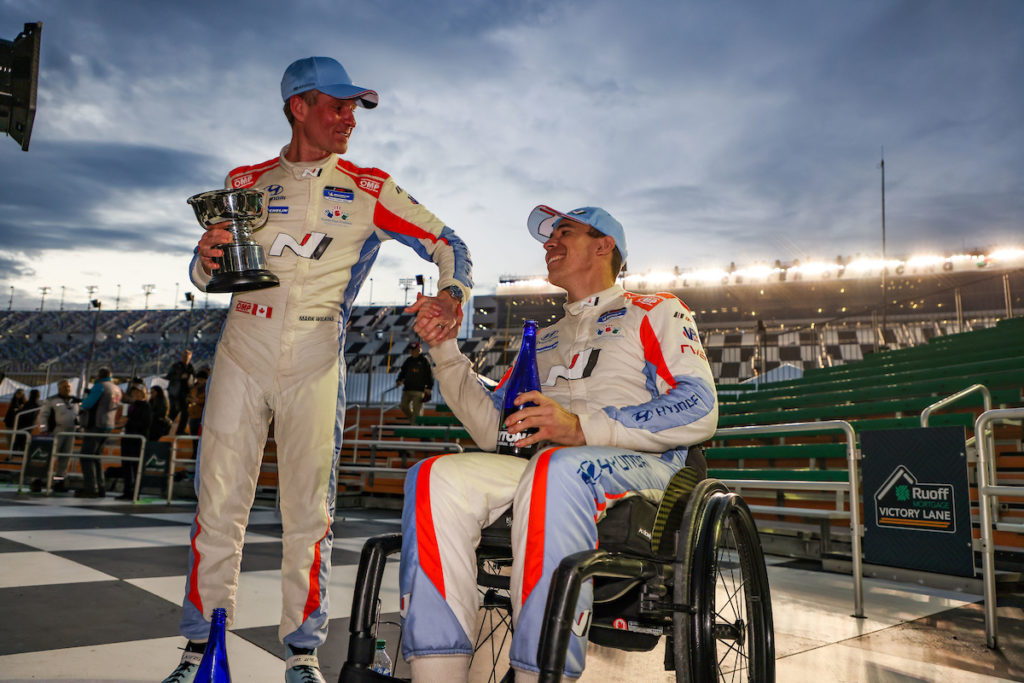
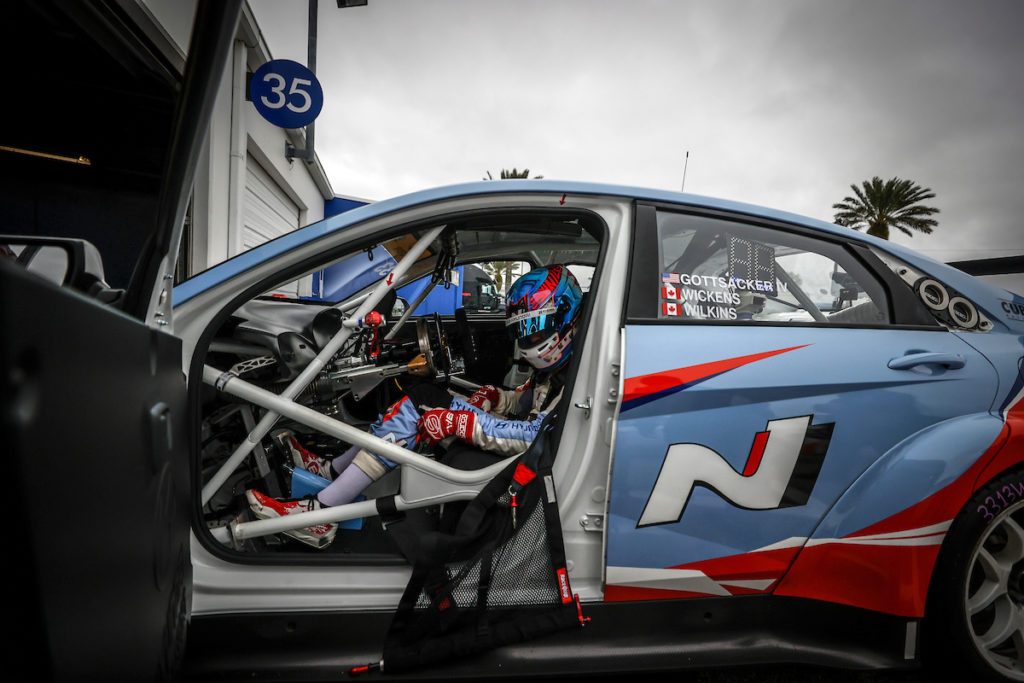

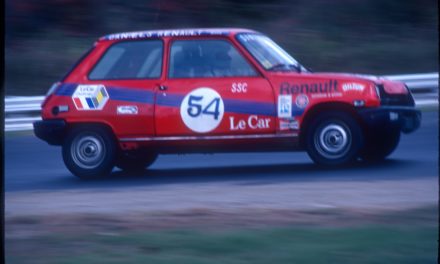
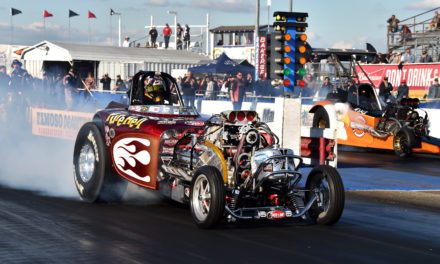



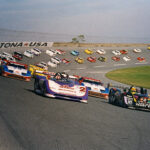
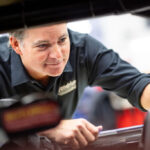
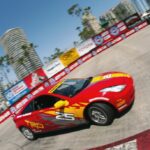
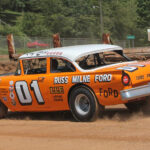
hats off to Brian Herta for his support, and to Wickens’ as he continues to pursue his passion after such tragedy. they both set the example we should all learn from.